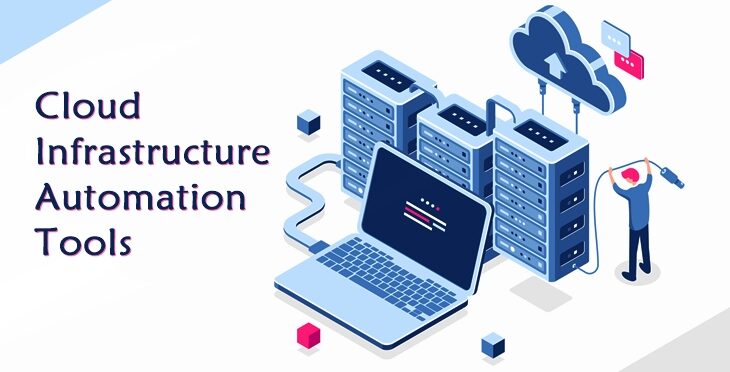Almost all enterprises are looking to make the shift to the Cloud. Many have already completed the process of shifting, while some are in the process or still evaluating. Shifting to the Cloud, though, is not an easy task. It requires a lot of initial setting up. It might even make you think again if it is worth the hassle of saving operating costs and reduce efforts. To address this very challenge, a lot of Cloud Infrastructure Automation tools exist. These Cloud Infrastructure Automation software are made with a singular purpose. They are for automating and easing the set up and managing your Cloud infrastructure. This way, your migration process is a smooth sailing endeavor. There are many Cloud Infrastructure Automation software available in the market. One solution fits all doesn't stand true here, and evaluating the whole bunch can consume more time than is reasonable.
Here is a collation of the 14 best Cloud Infrastructure Automation tools for you to consider and hopefully make a quick decision.
Cloud Infrastructure Automation Tools
- NetApp Cloud Volumes ONTAP
- CFEngine
- VMware vRealize Automation
- SaltStack
- Cisco Intelligent Automation for Cloud
- Microsoft Azure Automation
- Google Cloud Deployment Manager
- Hashicorp Terraform
- Kubernetes
- Chef Automate
- Red Hat Ansible Automation Platform
- Puppet Enterprise
- AWS CloudFormation
- IBM Cloud Schematics
A lot of top IT and technology players have forayed into the Cloud Infrastructure Automation software market. There are some small to medium-sized players as well. The list of cloud infrastructure automation tools are as follows:
NetApp Cloud Volumes ONTAP is a tool targeted towards storage management. It helps to keep the data on the Cloud safe, secure, and manage it properly to ensure optimum use of the space available.
The cloud infrastructure automation software has a capacity of managing 368TB. The tool can manage file sharing, backups, database archiving, recovery in case of any issues, and so on.
It is available in two variants –
- Single node configuration
- Enterprises as a high availability configuration.
CFEngine is a tool that is compatible with a wide array of enterprise IT infrastructures. Be it a small setup or a large one, CFEngine can manage and automate them all.
What differentiates this tool from others is that it does not use a central management server. Instead, it uses autonomous agents that keep a check on the configuration every five minutes. It can also manage up to 5000 hosts in each of its management servers.
Many organizations prefer opting for Amazon Cloud. Hence CFEngine integrates seamlessly with the Amazon EC2 infrastructure.
VMware's cloud infrastructure automation tool is available for single and multi-cloud setups. Hence, it is useful for SMEs as well as large conglomerates.
Some of its features include Cloud assembly, infrastructure automation, workflow management orchestrator, and recovery manager in case of failures.
The software uses Active Directory to manage the accesses provided. This helps give consistent governance and compliance experience in the case of multi-cloud infrastructure.
vRealize Automation is available in Advanced and Enterprise editions. The pricing varies on the size of deployment.
SaltStack started as an open-source project but later joined with an enterprise. This allowed them to grow more and provide better service and support to its customers. It can work almost autonomously, without agents.
You can deploy agents if your workflow asks for it. SaltStack's primary focus is on automating the security compliance of the Cloud migration and deployment.
With this tool, configuration and managing the data on the Cloud becomes very easy.
Some features of SaltStack include security compliance tooling, agentless node management, and seamless integration with almost all cloud service providers. It is a go-to tool for enterprises looking for security at their Cloud deployment.
Cisco is a major player in the Cloud and automation services space. It has a wide range of offerings, even in the cloud space – such as public and hybrid cloud solutions.
Its Cisco Intelligent Automation for Cloud is an offering in extension to its Cloud offering. This ensures users can avail themselves all the required facilities under a single roof. This is similar to what Amazon, Google, IBM, Microsoft, and other players do.
This tool, though, also works in other Cloud environments. It consists of a self-service portal from which the users can easily manage their Cloud environment through the tool.
Azure Automation is a tool that works in both Azure Cloud and other cloud environments. It contains many features that help manage your Cloud migration and deployment with ease.
It also provides Automation in managing the compliance and maintenance of the Cloud infrastructure.
Some features provided include update management, process automation, and various other configuration related features.
For those opting to move to the Cloud with Google Cloud Computing, the Google Cloud Deployment Manager is the tool for you.
It uses parallel and repeatable deployment. It also uses configuration templates to automate the configuration and deployment.
Enterprises can use the tools made available by Google, such as CLIs, APIs, and GUIs. They can manage all the phases of the configuration and management of the cloud environment.
Also Read: Cloud Migration Process Explained in Easy Steps
Infrastructure management is also known as 'infrastructure as code.' Terraform happens to work on this philosophy.
Using Terraform, one can create and change the infrastructure components. But, the tool is not exactly used to configure the cloud environment. It is not quite an automation tool.
Here, one can create and change high-level resources. This will still need an automation tool, but it is imperative to have Terraform for your Cloud deployment and management. This is because Terraform helps configure the resources and assists in the planning and execution of resources.
Kubernetes was developed by Google, and then it moved to become an independent tool. It is not an automation tool for the Cloud infrastructure directly, but it helps manage all the containerized applications.
Kubernetes is backed by all the top players and thus is compatible with all the Cloud environments available. This makes it easy to deploy and operate the Cloud environment for enterprises and manage resource consumption by applications across the entire environment.
Chef is a seasoned tool that has undergone a lot of development to become the capable product that it is today.
It provides its DSL to manage the policies of configuration and the production code's continuous delivery. Those using Chef's commercial platform have an extra feature of automating the hourly management of their self-hosted AWS deployment.
Some of the key features in Chef include GUI based workflow pipeline creation, compliance management, and ensuring high availability at all times. The tool can easily integrate with all major Cloud service provider environments.
Ansible was originally an independent and open-source project. It was later acquired by Red Hat to be added to their commercial offerings. It's USP is that anyone can use Ansible as it has a very easy and user-friendly interface.
Ansible claims that one doesn't have to be a professional and understand the mechanics to use Ansible. It is that easy to use. It allows the users to manage the entire cloud environment and automate it without needing a single agent.
Some of its features include job scheduling, multi-playbook workflows, flexible APIs, and GUI-rich inventory management. Ansible can seamlessly integrate with all major cloud service provider environments.
Puppet has been a market leader for a considerable duration and thus is one of the best offerings available today. Its enterprise version provides the capability to manage all the aspects of the Cloud, such as storage, network, and so on.
Using Puppet in the beginning, is a bit of a learning curve, but once that is completed, it is very convenient and easy to use this feature-rich tool. The software has partnered with many Cloud providers including all the major players available in the market.
Amazon is inching towards gaining a leadership position in the Cloud space at a very rapid pace. To keep everything in-house, it has also launched its own Cloud Infrastructure Automation software.
The tool allows the modeling of resources in YAML or JSON formats and automates them during the deployment phase.
In the case of using AWS cloud offering, the CloudFormation makes configurations very simple.
Many additional AWS tools are available with this tool and are included in the subscription.
IBM Cloud Schematics helps professionals and enterprises manage the cloud infrastructure in a much more efficient way. They can code the infrastructure to create, change, and use resources in the way they want.
Moreover, since it is an automation tool, deployment and management can be automated. The IBM tool helps make the code transparent and easy to use and work upon if needed.
It has a dedicated changelog so that one can know when any modifications were made to the code. Who made the changes and what were the changes made can be easily tracked with IBM Cloud Schematics.
Conclusion
If you are looking for Cloud infrastructure automation tools for your enterprises, you need not look further than this list. You will find the optimum solution for you among the mentioned list of Cloud infrastructure automation software. Evaluate them to see which suits your organization the best, and then it will be easy to make a decision.
You May Also Like to Read:
5 Real Life Examples of Hybrid Cloud
Cacti vs Nagios: Comparison between the two Network Monitoring Tools
Cloud Data Warehouse Modernization: Its Advantages & Mistakes to Avoid
What is The Distributed Cloud: Advantages and Disadvantages





